Francesca and Henk-Jan's Backpacking Trip!
Sunday, August 15, 2010
A Taste Of Tibetan Culture
I’ll take over writing again! It is the 14th of August and we’ve just had something to eat for a late (around 3:30 PM) lunch. Henk and I were worried that we wouldn’t be hungry enough for our ‘dinner-and-a-show’ we asked Ray to book for us, since it was supposed to start just a few hours later. Luckily we had eaten light, so around 6:30 PM when we arrived at the Himalaya Hotel, we were actually a little hungry. Upon walking into the theater of the Shol Opera Troupe, we were a bit impressed! First of all, the theater itself was oxygenated, to help those suffering from AMS. Secondly, there were displays of Tibetan opera masks and interesting tid-bits of information in cases all around the room. And third, there was a nice big buffet or traditional Tibetan goodies set out for all of us to grab at! The waitresses first came along with our free drinks: a cup of butter tea, a small glass of Chang (the barley beer Tibetans drink), and sodas of our choice. We even noticed a special ‘energy-looking’ drink in their collection on the cart – one that had some altitude medicine included in it! Strange.
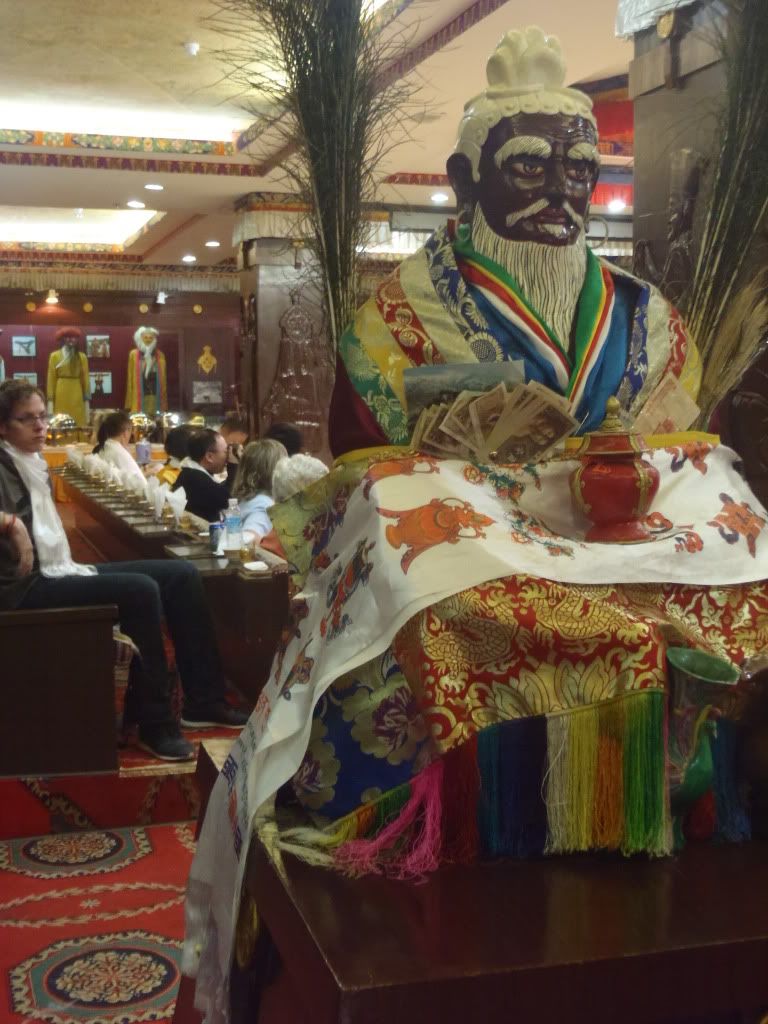
As I walked around the room scanning the cases, I saw tons of really cool masks, and lots of demon faces. A little introduction about Tibetan Opera from China Culture website:
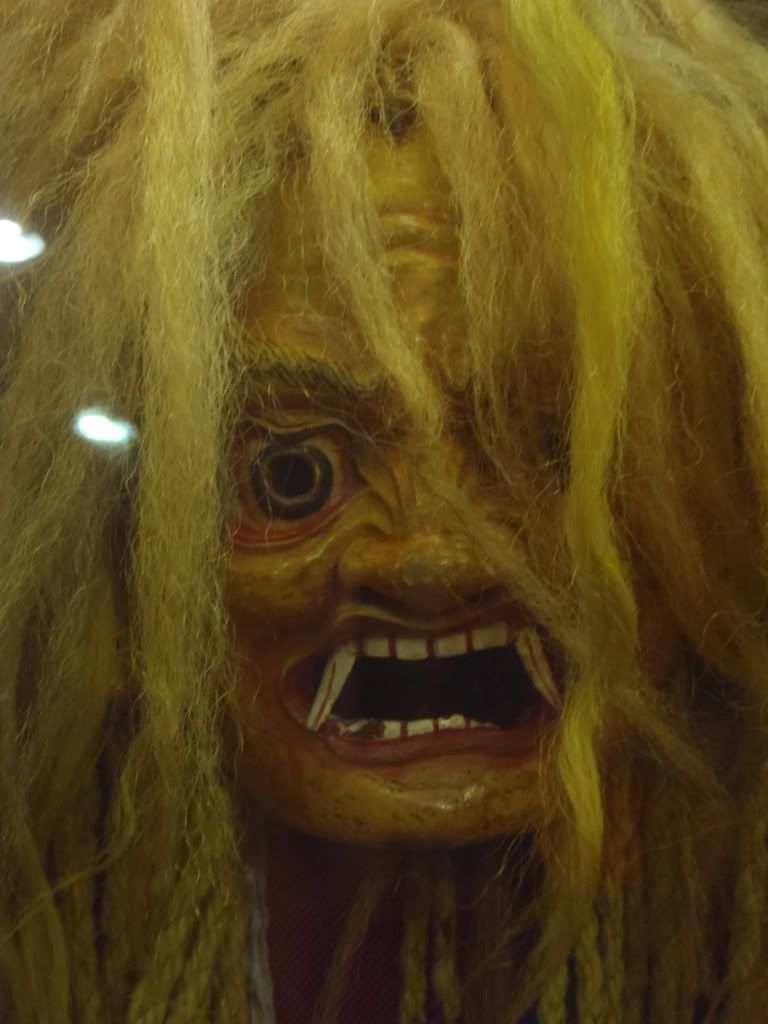
“There is a beautiful legend about the Tibetan Opera in its present form. During the 14th century, a high-ranking monk and bridge builder named Drupthok Thangthong Gyalpo decided to build iron bridges across all of the major rivers in Tibet to improve transportation and facilitate pilgrimages.
To fund the project, Thangthong Gyalpo created a singing and dancing group of seven beauties who danced while he played the cymbals and drums. They performed throughout Tibet to earn money for his bridge project. This is believed to be the source of the present Tibetan Opera.”
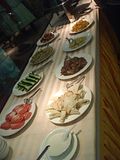
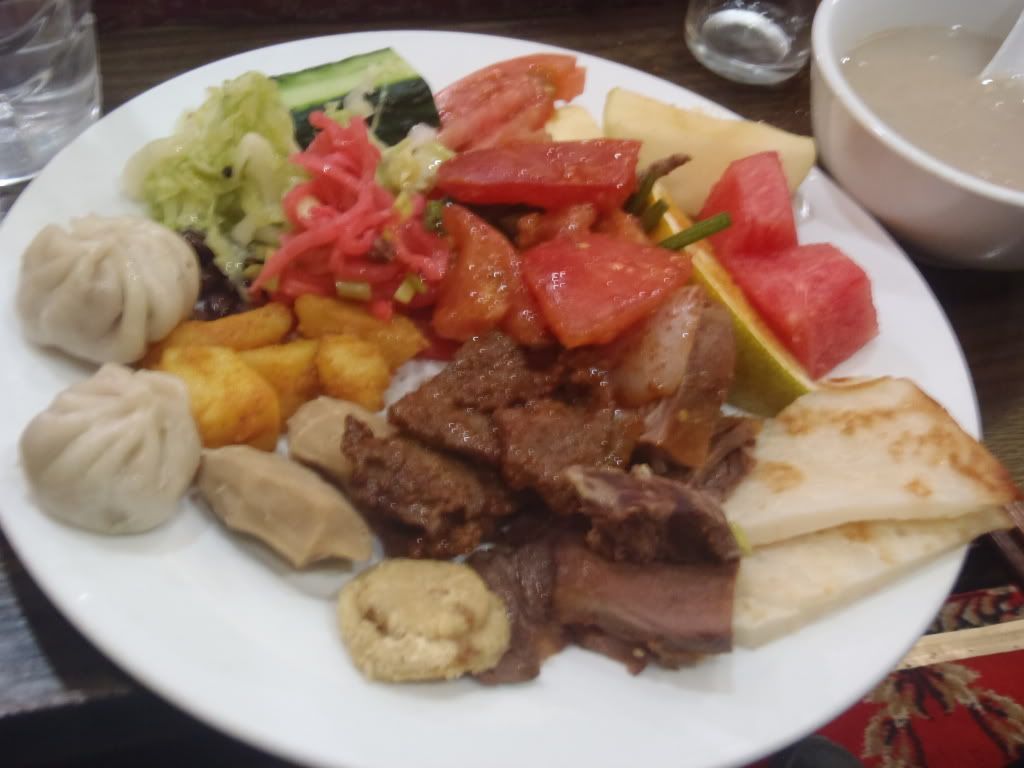
The shows we saw were a short and entertaining, and there were a bunch of them. The group started out with the ‘Blue Mask Sect Dance’ and then followed with an Eastern Tibet dance done by girls with guitars. The third dance we saw was the ‘Cham Religious Dance’ (one of the many types of Cham dances) and one of the ‘Lhasa-area traditional dances’ that I dubbed the ‘fuzzy-hat dance’ since that’s exactly what the girls wore. Finally, the show gave us a ‘Nomad Dance’ that involved nomads and people dressed up like yaks (not traditional, more like a short skit, but quite funny to watch!) and a dance they titled ‘Namtso Dance.’ The final show was a bit of a ‘fashion show of Tibet’ that involved men and women labeled from different ‘areas’ of Tibet coming out to show what clothing from their area looks like. At the same time, we were introduced to a few important figures in Tibetan history – the inventor of Tibetan writing, the founder of Tibetan medicine, the founder of Tibetan opera, etc.
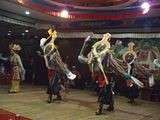
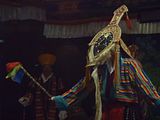
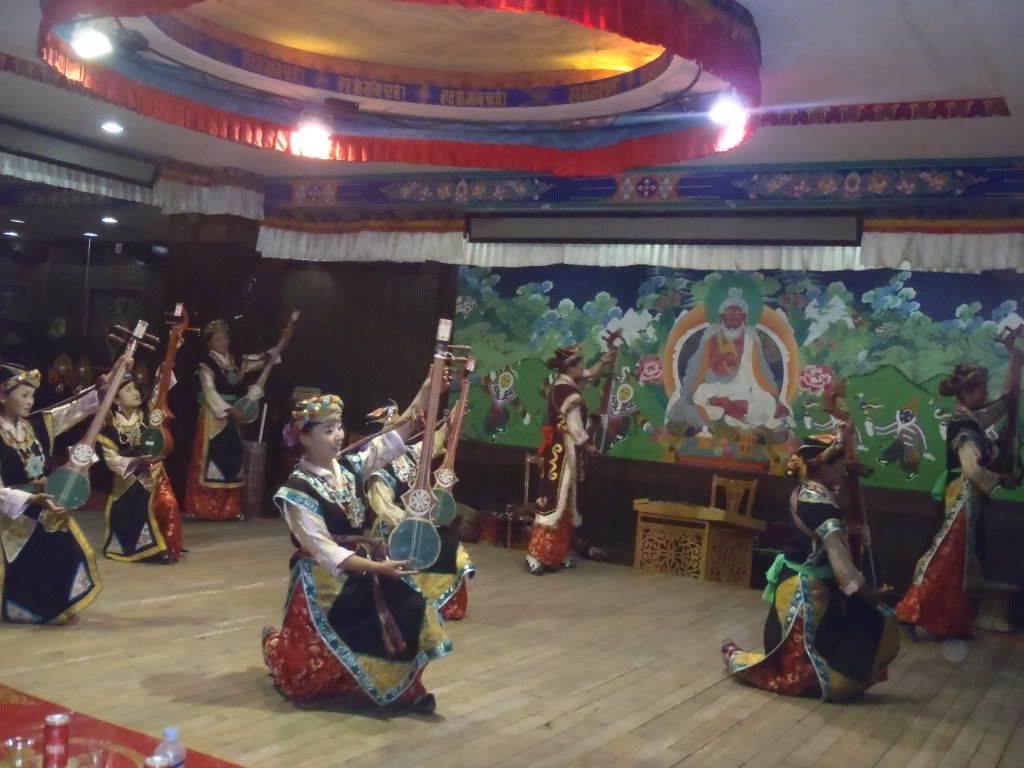
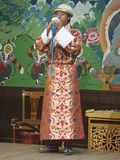
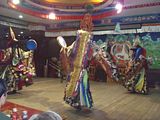
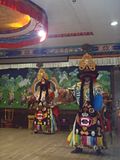
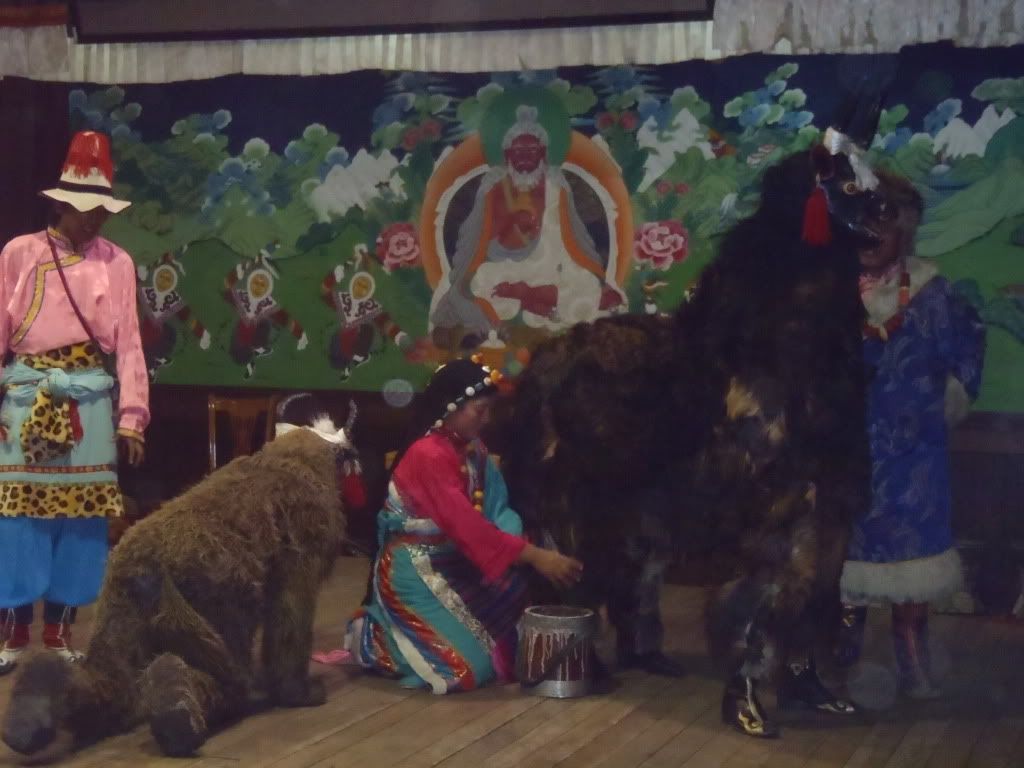


Once the show ended, we got to take a few pictures with the actors and actresses before heading back to our hotel. One thing I have to mention is as we were walking back, we realized that it was half past 8:00 PM at night, and it was still completely bright out. We quickly realized that Tibet was on the same time-zone as China (Beijing time) even though it’s a completely different location, making the area in reality more than 2 hours different by the sun. Since China thinks only of Beijing/Shanghai, this is the way it is! A sun that doesn’t set until nearly 9:00 PM at night… Also note the gigantic carcasses of yaks and cows we spotted all along the way. Our hotel was near the Muslim Quarter – since Buddhist abhor killing animals it only made sense for the Muslims to take up the noble job of butchering.

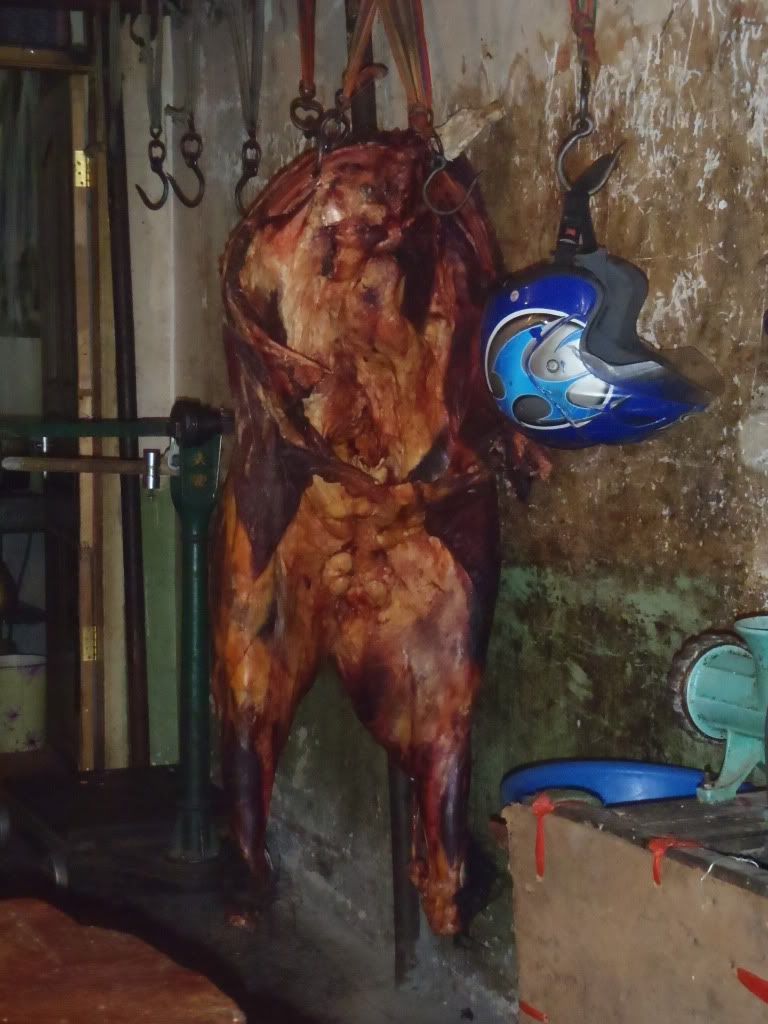
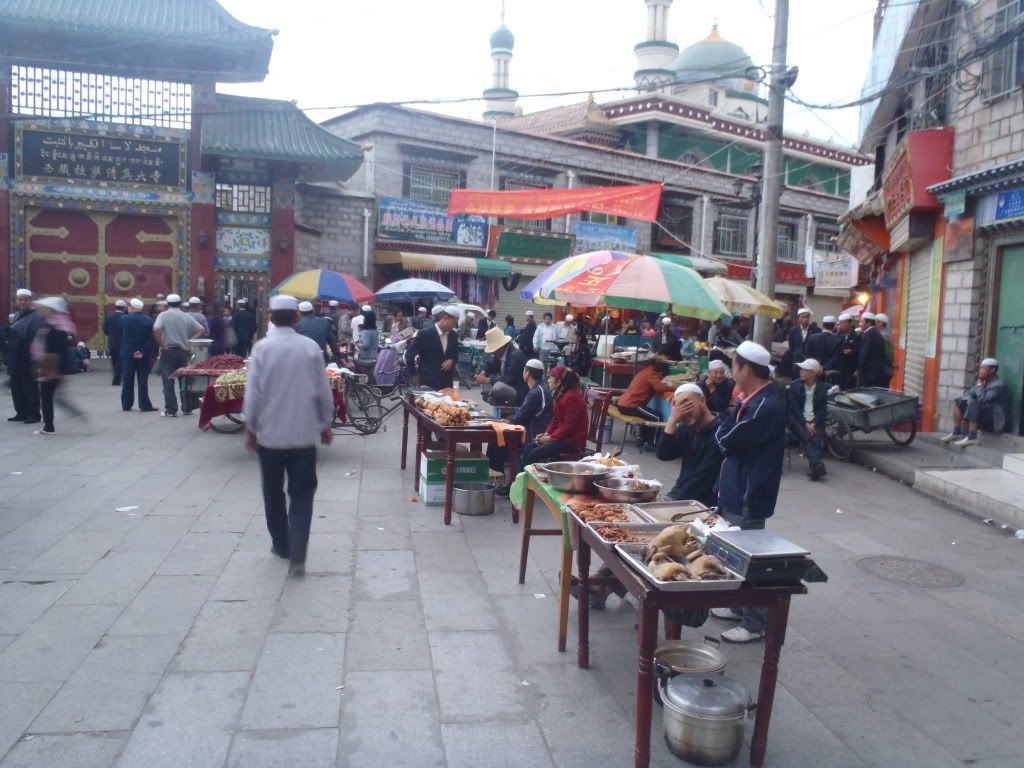
Anyways, the next morning we had to get up early to see our first sites in Lhasa. We’d passed by it now quite a few times, but we had yet to go into Jokhang Temple. Ray picked us up at the hotel and we were there around 10:00 PM to buy our tickets. It was insanely crowded, but turns out we were actually lucky. Ray explained that despite the temples’ vast 25,000 square meters and four stories, most times tourists are only allowed a strict 15 minutes in the temple due to the even more massive amount of visitors -- giving him hardly any time to explain the sites inside. But we didn’t have a time limit since it was a Sunday, the only day tourists are the only ones allowed inside. Jokhang Temple is the focal point of pilgrims to Lhasa, where they come to honor the founders of their country and the founders of Buddhism. The temple was built by King Songtsen Gampo in 647 AD and is thus one of the ‘must-sees’ of Lhasa. We made our way through the masses of people inside the temple, coming out onto a decently spacious courtyard. Here we took some time to understand the background of the temple.
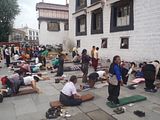
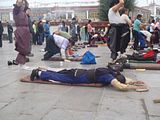
Here is some helpful information from the Lonely Planet Tibet, which we learned from Ray while inside Jokhang Temple:
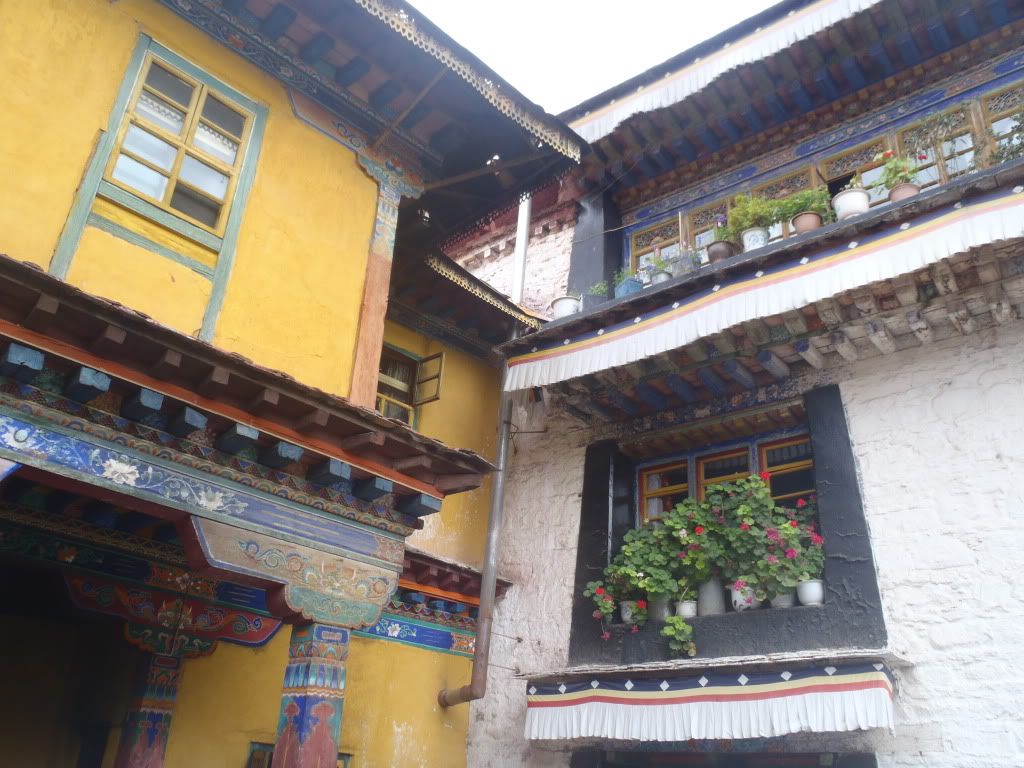
“[There is a story] …of a vast, supine demoness whose body straddled all of the high plateau. It was Princess WenCheng, the Chinese wife of King Songtsen Gampo, who divined the presence of his demoness. Through Chinese geometric calculations she established that the heart of the demoness lay beneath a lake in the centre of Lhasa, while her torso and limbs far away in the outer dominions of the high plateau. As in all such fables, the demoness can be seen as a symbol, of both the physical hardships of Tibet and the existing Bon clergy’s hostility towards Buddhism; both had to be tamed before Buddhism could take root there. It was decided that the demoness would have to be pinned down. The first task was to drain the lake in Lhasa of its water (read life-blood of the demoness) and build a central temple that would replace the heart of the demoness with a Buddhist heart. The temple built there was the Jokhang… a serious of lesser temples, in three concentric rings, were (also) conceived to pin the extremities of the demoness.”
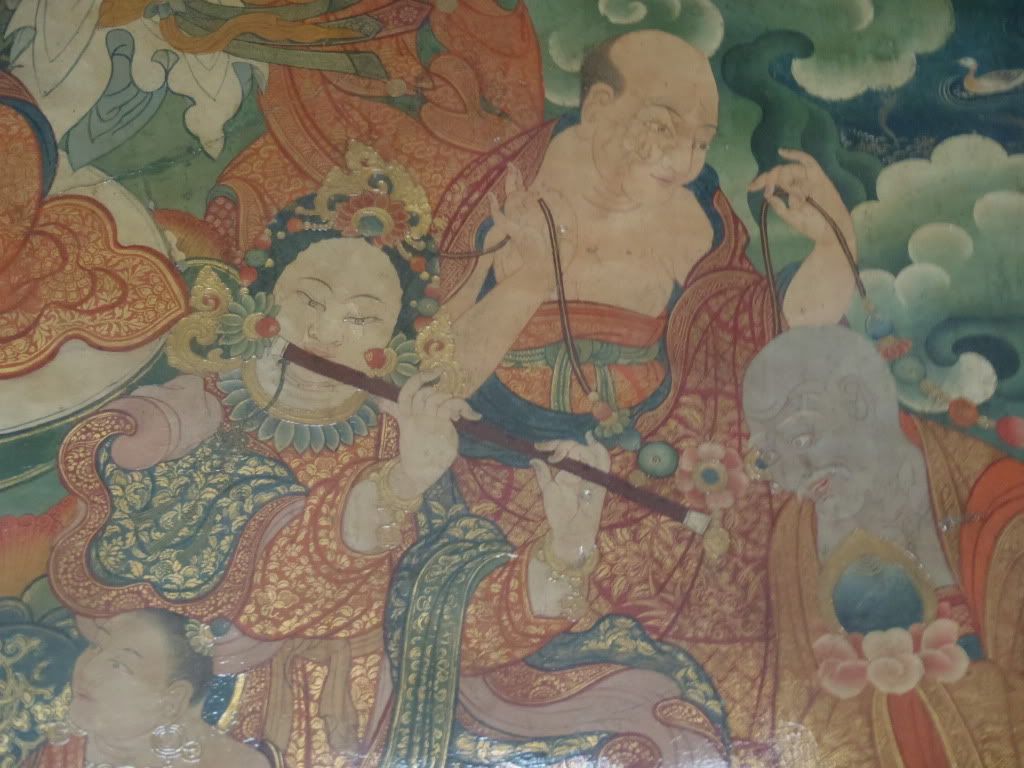
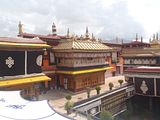
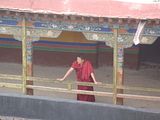
One of the sections of the temple we came to was covered in a mural. This mural depicted the temple’s construction, showing the temple being built over a lake and stupa, with goats helping the process by carrying earth on their backs to fill the lake. In fact, the temple was under construction while we were inside. We could see the workers on top of the roofs hitting them to mend the packed clay and dirt. While the process looked really sketchy, Ray insisted that this traditional method would leave the temple waterproof for up to 7 years! Later, when Henk and I climbed the stairs to the top of the temple, we witnessed a group of Tibetan construction workers breaking out into spontaneous dance in the middle of their work-- which Ray said was actually pretty normal for Tibetans! They are people prone to displaying themselves in song!
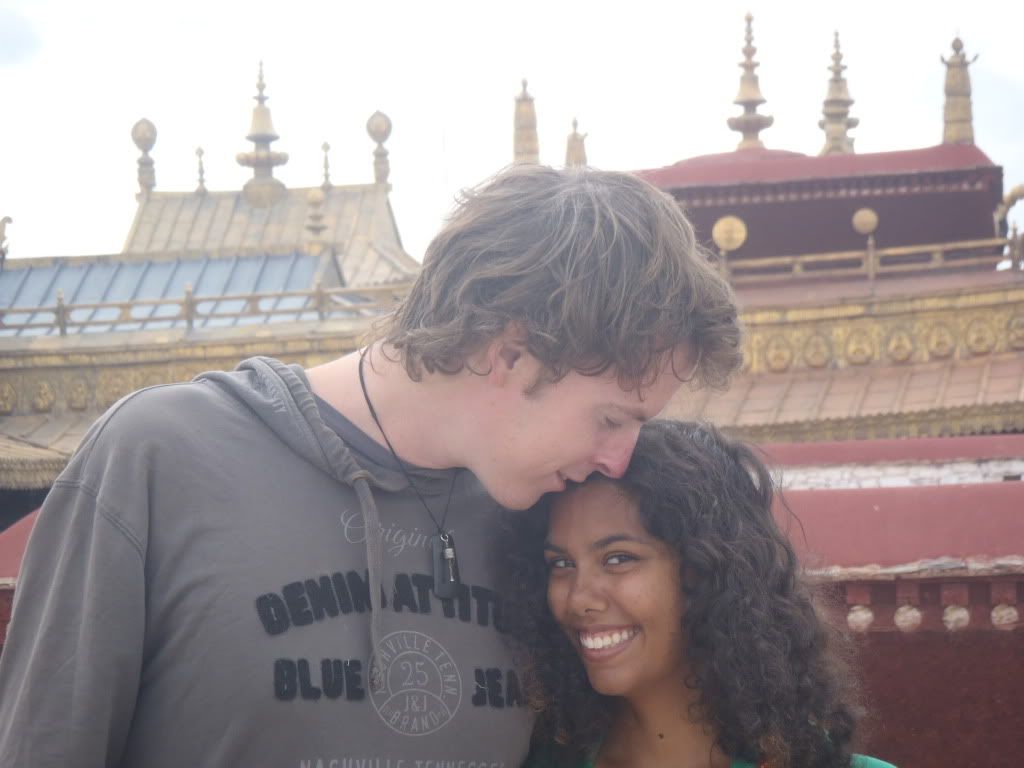
We learned the Dalai Lama (including the present 14th) used to preside over huge debates in the courtyard we stood in. There were once over 10,000 monks gathering here to question what others knew. Now the regulations imposed by the Chinese let hardly any ‘unsupervised’ monks gather in the area, let alone allow them to hold their former large debates. There was a huge cooking pot, bigger than the one we’d see at the festival, standing in the courtyard. Ray estimated it could feed 5000 to 6000 monks and explained that the money floating in the water on top was left by pilgrims.
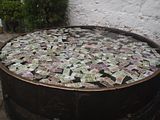
In fact, there was money pretty much everywhere you looked in the temple! At every statue someone was making a donation, at each display someone was smearing yak-butter on it for their devotion, or scooping yak-butter out of bags into large burners to light up and melt (thus making the temple smell constantly of baking cookies!) Our guide explained the symbolism of the butter by comparing putting butter in the burner plate to putting a drop of water into the ocean… neither have a huge chance of drying out/burning out right away once they are in a large ‘pool’ with others; thus they last longer and thus one makes more continuous merit on their one-time gift. We even learned that occasionally someone accidentally drops money on a ‘regular’ (non-holy) item or area and pilgrims, not knowing any better, think it must be something sacred and add their own donation as well! Better safe than sorry, I guess…
Ray pointed out to us the image of two deer, flanking either side of a large wheel. The dharma wheel is symbolic of Buddha’s teachings, specifically the path to enlightenment. This wheel of law is symbolized by an eight-spoked chariot wheel representing the eight-fold path, but there can be other numbers of spokes as well representing other aspects of Buddhism. The deer on either side of the wheel represent the Deer Park at Sarnath in India where Buddha taught his first disciples. Ray specified to us that since Buddhism believes our experience of life is a ‘long dream’ (as opposed to the ‘short dreams’ we have every night during sleep) the wheel of dharma aids us in our ultimate goal of enlightenment or ‘waking up from that dream.’ This occurs when realization sets in and emotion is thus extinguished… but this takes multiple lifetimes and rebirths for one mind to achieve.
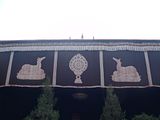
Then the three of us walked around the inner chambers of the temple, while Ray pointed left and right at various images, telling us little bits of information about their lives.
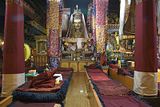
Mara, for instance, was a demon who constantly tried to tempt the Buddha with visions of beautiful women. While he is a demon, Mara has not traditionally been seen as ‘evil’ but rather as annoying – in fact, many of the stories involving Mara’s antics are more humorous in nature than good/evil battles. The wiki has a nice little chart of the ‘four senses’ in which Mara is understood by Buddhists; they are as follows:
• Klesa-mara, or Mara as the embodiment of all unskillful emotions.
• Mrtyu-mara, or Mara as death, in the sense of the ceaseless round of birth and death.
• Skandha-mara, or Mara as metaphor for the entirety of conditioned existence.
• Devaputra-mara, or Mara the son of a deva (god), that is, Mara as an objectively existent being rather than as a metaphor.
Another image we saw was Vajrapani whose name is a combination of ‘thunderbolt/diamond’ and ‘in the hand.’ This is exactly what his representation looked like! His eyes were wide and bulging, his hair was completely wild in all directions, and he looked really, really powerful. This is pretty apt since he is supposed to be the figurative representation of the Buddha’s power as well as the Buddha’s protector.
Next we saw a stupa that was “self-raising,” meaning humans don’t know where it came from/didn’t create it. There was also the ‘Temple of Compassion Buddha,’ and Henk and I understood that the ‘Compassion Buddha’ actually represents the 14th Dalai Lama – since he is believed to be a reincarnation of this Buddha, which one can recognize by its 4 arms or 11 heads. The reason the Compassion Buddha looks the way it does is because it cannot handle the suffering of all people and have compassion for all of them, but still it tries to do so. As a result, the Compassion Buddha ‘breaks,’ splitting itself into multiple parts so that it has more arms to help, eyes to see, minds to feel, etc.
We now approached the most important chapel in the temple: (and in fact, in all of Tibet) the ‘Chapel of Jowo Shakaymuni.’ This image houses a 1.5m sitting image of Shakyamuni at the age of 12. The Jowo image was a gift from the Chinese Princess Wencheng to her husband King Songtsen Gampo, and was miraculously protected from the Chinese Red Guards during the ‘Cultural Revolution’ their leader Mao Zedong spearheaded that completely decimated almost all of Tibet’s ancient religious and cultural artifacts, including 6,000 of Tibet’s 6,400 temples.
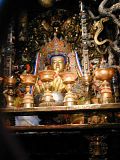
The Wiki explains the statue’s origin as a gift, and the ancient effort to protect it:
“Jowo Rinpoche statue was owned by the king of Magadha who gave it to a Tang emperor of China, whose daughter, Wenchen Kongjo, who carried it to Lhasa via Lhagang in a wooden cart when she married King Songtsen Gampo. During Mangsong Mangtsen's reign (649-676), because of a threat that the Tang Chinese might invade, Princess Wen Cheng is said to have hidden the statue of Jowo Rinpoche in a secret chamber in the Jokhang.”
This chamber was built to look as if there was a wall rather than a door, and we passed the hiding chamber shortly after viewing the statue itself.
A description of the statue from a travel photo site: “The Jowo sits on a majestic massive three-tiered stone platform. Two silver-plated dragons presented by the Chinese emperor entwine the ornate pillars that support an intricate double canopy over the Jowo. An ornate crown of coral, turquoise, diamonds, rubies, and other precious gems, sits on the Jowo’s head.” Henk and I followed Ray a bit closer to the image, where we saw Buddhist monks doing something that looked quite strange. “Are they painting it?” I asked in disbelief. From this question we learned that Buddhist pilgrims who are eager to show their level of dedication to the Jowo image buy liquid gold to add to the face or body. It supposedly cost just 480 RMB (US$70) to give the Buddha’s face an extra coating of gold leaf.
We watched the painting in awe until we were pushed further on – there were so many people! We next went upstairs and explored the open roof of the temple where we could take tons of pictures of the surrounding streets and structures. Here are some of the results:
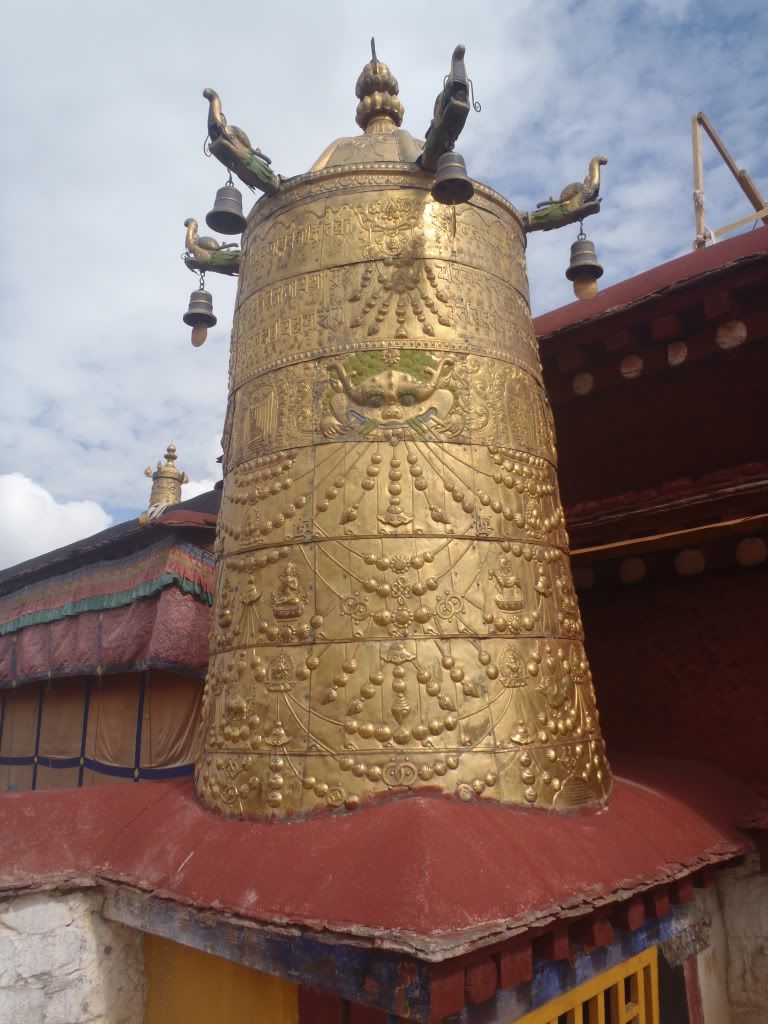
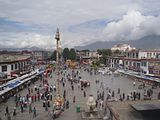
Finished with the Jokhang, the three of us explore the streets of Barkhor, going into a few interesting shops and walking through the markets. We soon came across one of the stalls selling colorful thread bunches, the same thread the Tibetan women all had in their braided hair. Henk and I asked Ray if he could ask the stall keeper if she would mind braiding my hair if we bought some threads from her. She complied cheerily, looking amused that I wanted to look like a local Tibetan. Once my new hairstyle was in place, we took a break and popped into a traditional tea house for a sip of sweet milky tea. After that our shopping walk continued until we arrived at the Yak Hotel – one of the more famous places to stay in Lhasa. It was here that we were supposed to meet Sam, the girl I contacted online to join us on our Tibet trip. Her taxi ran a bit late so we chilled out in the lobby, and when she finally arrived we made a quick stop to drop her bags at the agency that arranged our tour before heading for lunch.
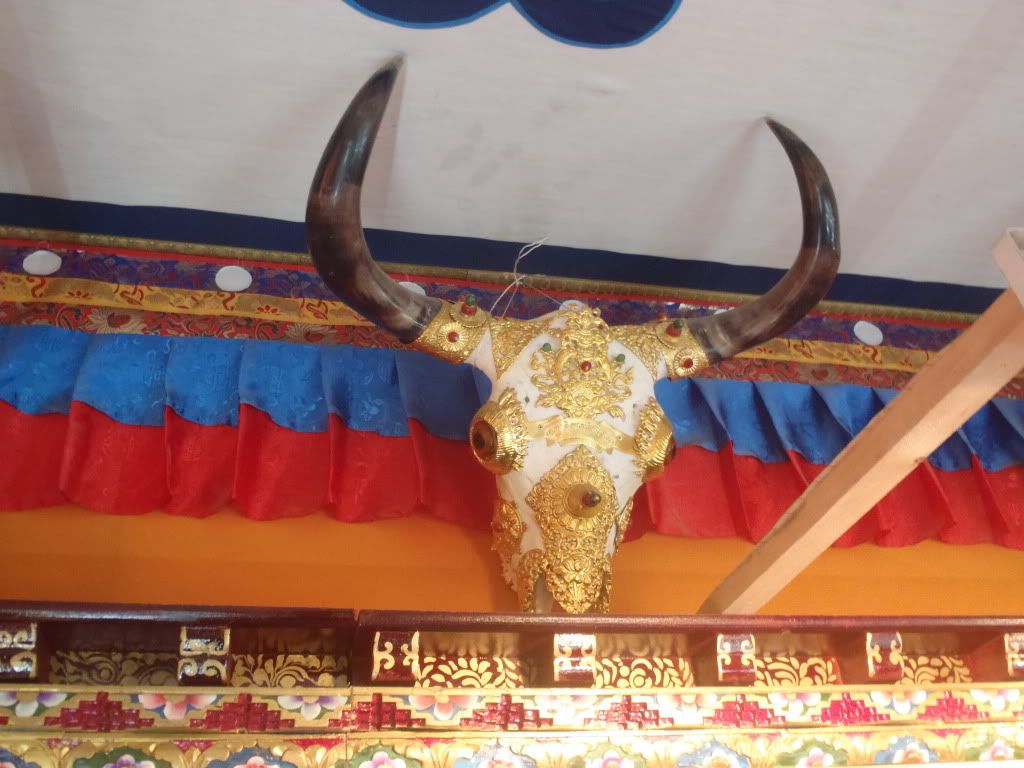
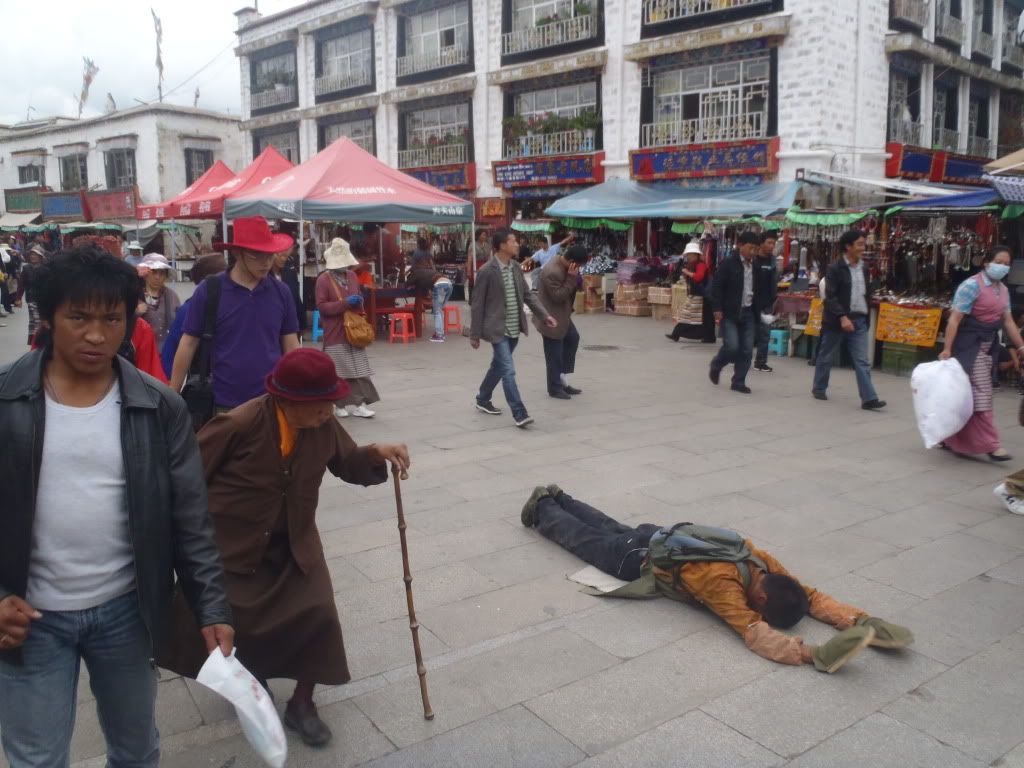
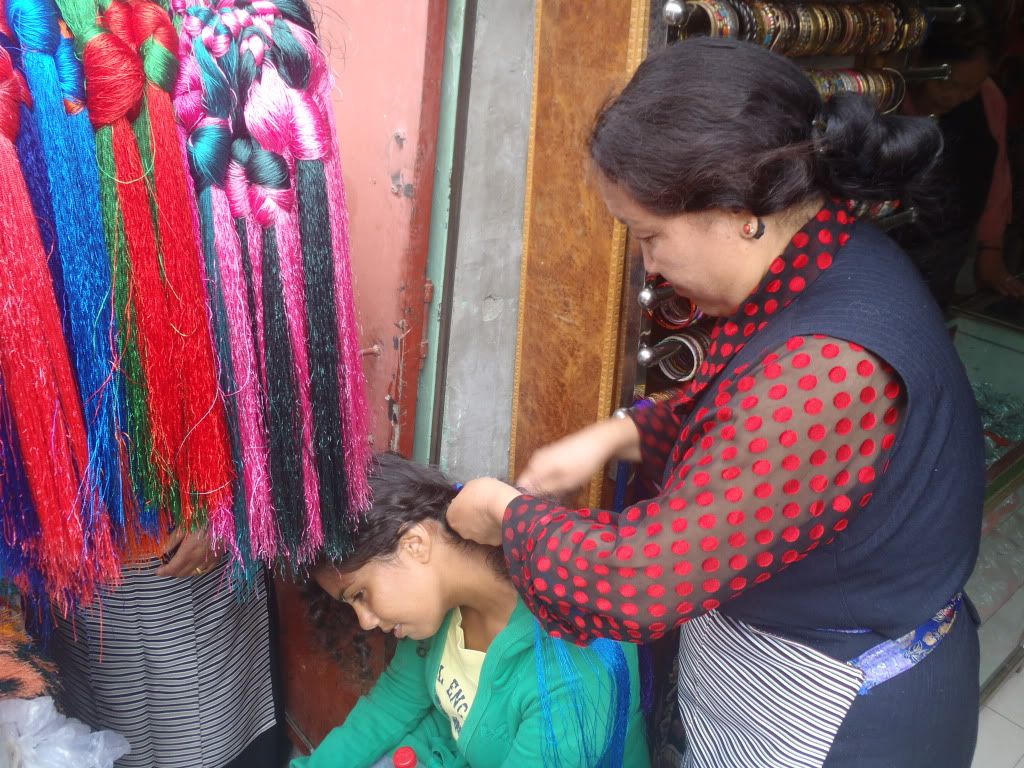

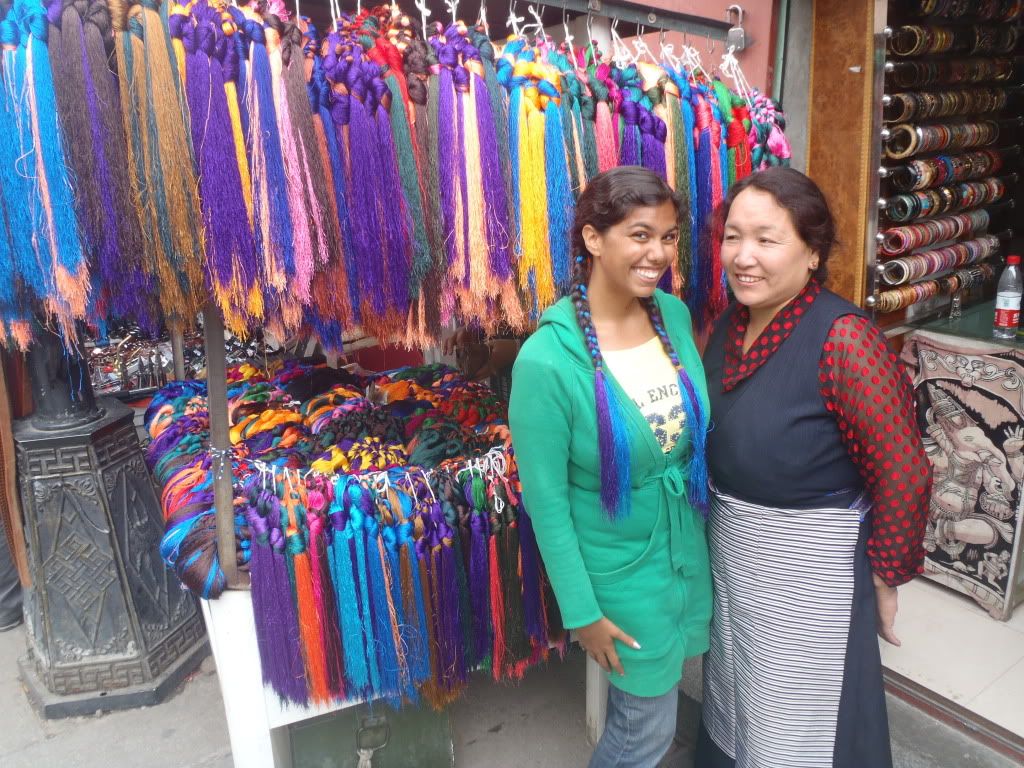
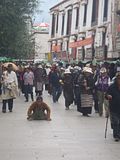

After a quick lunch at Snowland of delicious butter chicken and butter naan for myself and amazing yak sew for Henk (I recommended it cause it sounded good!) which turned out really, really good, we took a taxi to Potala to book our tickets for the next day. After that we had a date with Norbulingka, the former Dalai Lamas Summer Palaces’, around 3:00 PM for a visit so we took another taxi and were there in a flash.
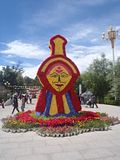
Norbulingka (the name meaning ‘Treasure Garden’ in Tibetan) is a group of summer palaces built in the mid-1700’s for the 7th through the 14th Dalai Lamas. It was the traditional summer residence of the successive Dalai Lamas from the 1780s up until the Chinese takeover in the late 1950s. Not all of the Dalai Lamas built their own little palace, but some of them simply used the already-constructed palaces of former Dalai Lamas. The notable Lamas who built their own palaces were the 7th, 8th, 13th, and 14th. While the nearby Potala Palace was the winter residence of the Dalai Lama and his staff, Norbulingka was the summer residence, and even included large outdoor gardens to emphasize this. It’s common that during the summer, people come to ‘chill out’ in the park and when we arrived there we saw them all hanging out for the festivities of the current Shoton Festival. There was also a zoo apparently in the park but we weren’t excited about going inside since Ray heard from a friend that the animals looked really horrible and were being treated pretty badly. We won’t pay money to support that!
We first came across the 7th Dalai Lama’s palace, Kelsang Potrang. From a Tibet tourism website: “... is a perfect example of yellow hat architecture. Built by the 7th Dalai Lama, this is 3 floor building which has bedrooms, reading rooms, worship halls and a sanctuary as well.”
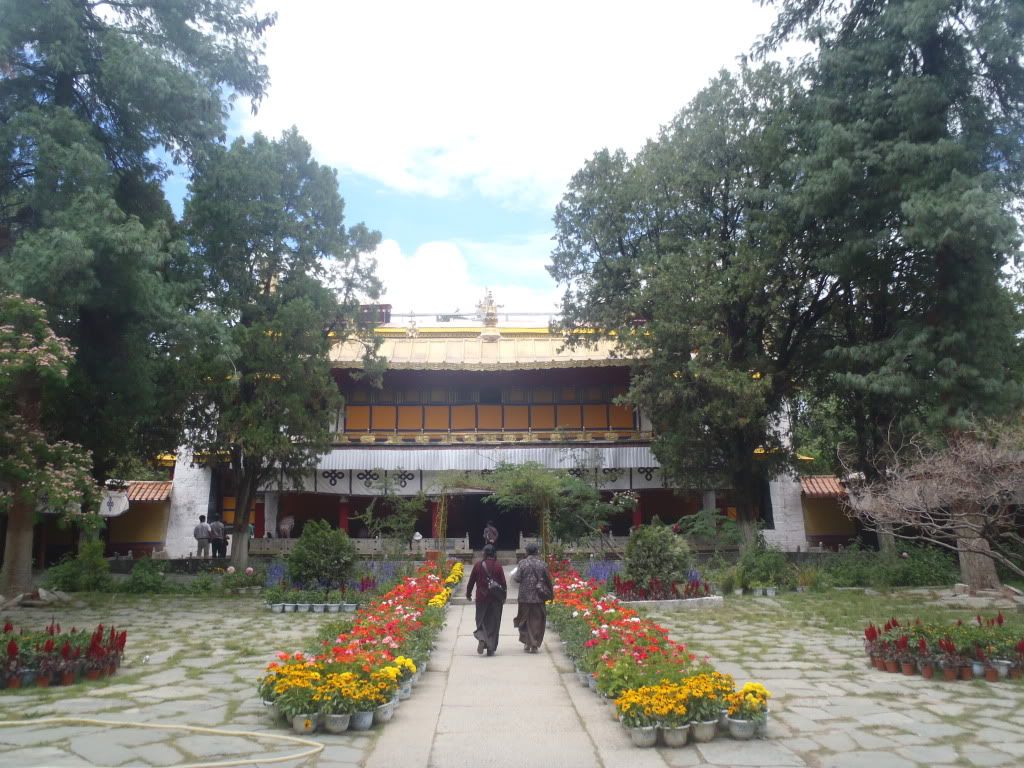
It was here that we learned some information about the various females (or female aspects of male figures) in the Buddhist pantheon, including White and Green Tara and the female longevity Buddha. Tara is one of the most popular figures in Tibetan Buddhism. She is the “mother of liberation” and is represented in many different forms of Tara – green Tara, white Tara, red Tara, etc. Tara represents success in work and victory in achievements. A good story about Tara’s origin and list of Tara-types from Wiki:
“… there is a young princess who lives in a different world system, millions of years in the past. Her name is Yeshe Dawa, which means "Moon of Primordial Awareness". For quite a number of aeons she makes offerings to the Buddha of that world system, whose name was Tonyo Drupa. She receives special instruction from him concerning bodhicitta — the heart-mind of a bodhisattva. After doing this, some monks approach her and suggest that because of her level of attainment she should next pray to be reborn as a male to progress further. At this point she lets the monks know in no uncertain terms that from the point of view of Enlightenment it is only "weak minded worldlings" who see gender as a barrier to attaining enlightenment. She sadly notes there have been few who wish to work for the welfare of beings in a female form, though. Therefore she resolves to always be reborn as a female bodhisattva, until samsara is no more. She then stays in a palace in a state of meditation for some ten million years, and the power of this practice releases tens of millions of beings from suffering. As a result of this, Tonyo Drupa tells her she will henceforth manifest supreme bodhi as the Goddess Tara in many world systems to come.”
The most widely known forms of Tara are:
• Green Tara, known as the Buddha of enlightened activity
• White Tara, also known for compassion, long life, healing and serenity; also known as The Wish-fulfilling Wheel, or Cintachakra
• Red Tara, of fierce aspect associated with magnetizing all good things
• Black Tara, associated with power
• Yellow Tara, associated with wealth and prosperity
• Blue Tara, associated with transmutation of anger
• Cittamani Tara, a form of Tara widely practiced at the level of Highest Yoga Tantra in the Gelug School of Tibetan Buddhism, portrayed as green and often conflated with Green Tara
• Khadiravani Tara (Tara of the teak forest), who appeared to Nagarjuna in the Khadiravani forest of South India and who is sometimes referred to as the "22nd Tara."
The female longevity (which we were told was in the palace as a desire for the Dalai Lama to live a long life) Buddha, known as Usnisha-vijaya, is described as follows by the Wiki:
“She is an 8-armed longevity deity, who also stands for the Mother of All Buddhas. Like all Buddhist deities, she is essentially a manifestation of Emptiness acting as a bodhisattva. She is able to bestow longevity on beings not for selfish reasons, but for the purpose of helping all others towards enlightenment. She is a purification deity as well, invoked in the presence of the dead, and she is also invoked as a means of settling disputes.”
One of the décor elements I immediately noticed was the abundance of ‘Victory Banners’ (which looked like neckties to me) hanging all over the place inside the little palace. It was explained that these banners stood for victory over cruelty rather than any beings. For Tibetans there are 11 different types of victory banners, as they represent the 11 different methods to “overcome defilement.” We also saw a display of 7 carefully lined up bowls filled with water in front of some of the worshipping displays. In Buddhism, it does not matter if one can afford to offer gold or just simple water. What is important is your intention rather than the specifics of your act… if you wish you could offer gold but offer water, you might as well have offered gold! On the other hand, if you wish you didn’t have to offer anything or show respect, and you offer the maximum amount of gold, no good will come of this act. You didn’t really mean it!
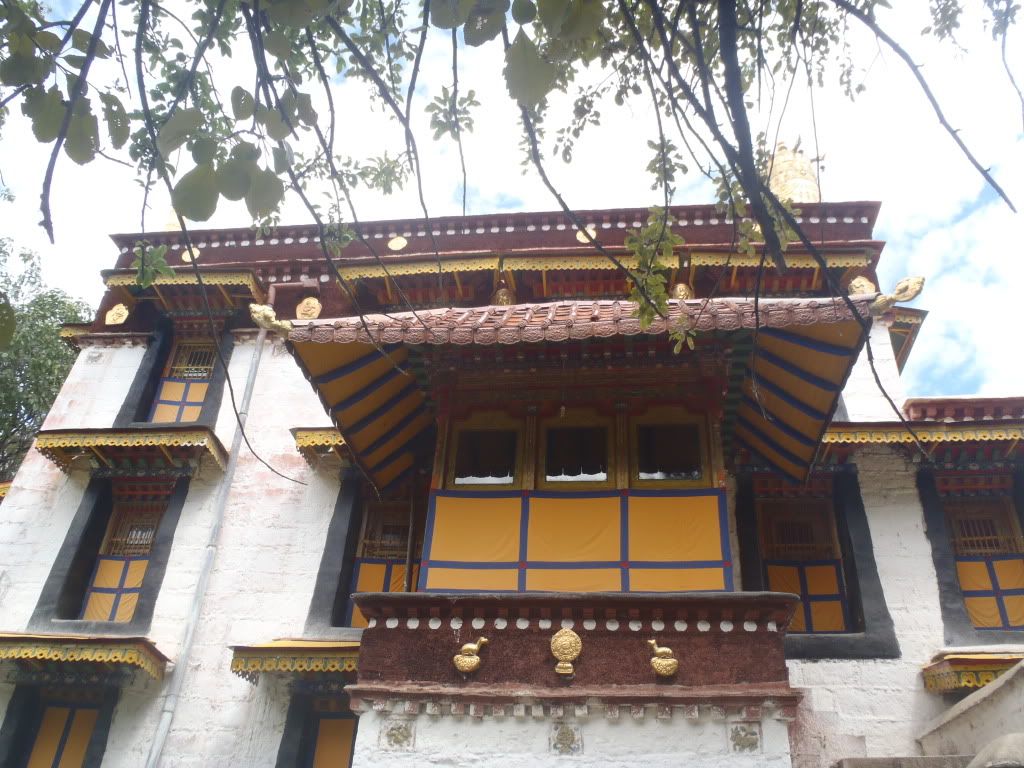
The palace built by Jampel Gyatso, the 8th Dalai Lama, was called Tyoksil Potrang and was surrounded by water elements. The 8th Lama added on a lot of the palaces and gardens to the complex including three temples and a bunch of fruit trees.
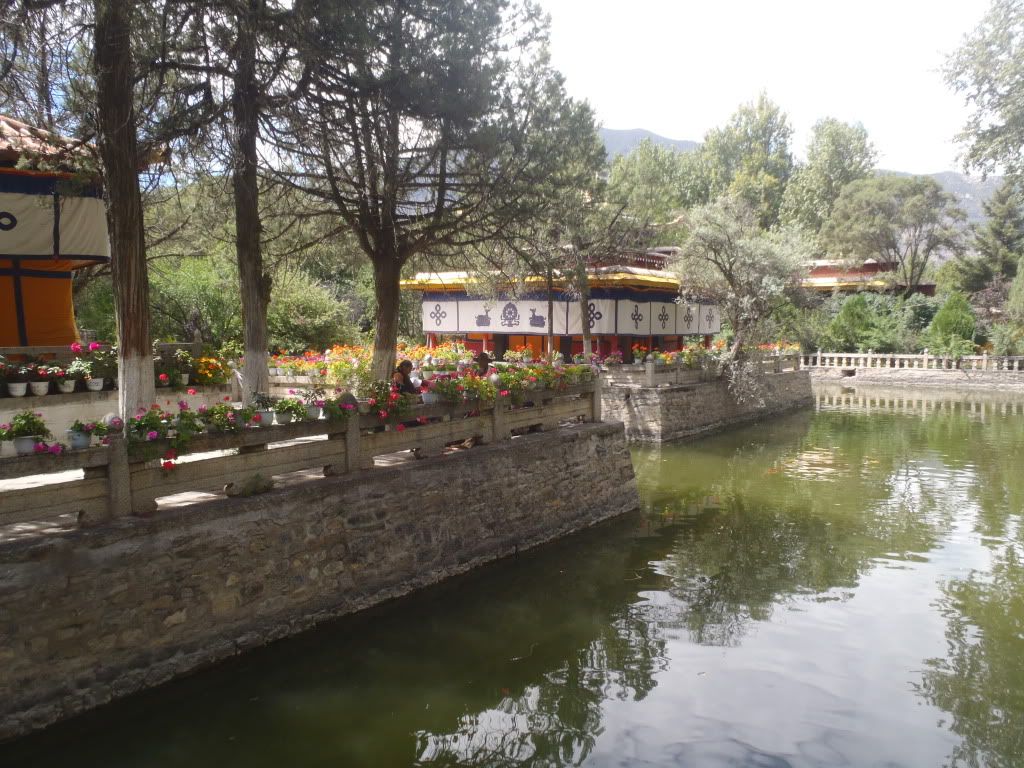
It was the 13th and 14th Dalai Lamas who really brought the summer palaces to life, however. The 13th added huge red doors in the palace and had multiple carriages that had been presented to him by India, Nepal, China, etc. stored inside his palaces known as the Golden Lingka and Chensel Potrang.
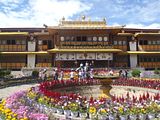
The 14th Dalai Lama was reincarnated in the Amdo area of Tibet – and, as the traditional Buddhist thought goes - reincarnated in three areas: speech, body, and mind. From the time the previous Dalai Lama dies it takes 49 days for the Dalai Lama to be reborn. According to Wiki, there was a test given to the current Dalai Lama to determine if he indeed was the reincarnation of the previous Dalai Lama: “The little boy was presented with various relics, including toys, some of which had belonged to the 13th Dalai Lama and some of which had not. It was reported that he had correctly identified all the items owned by the previous Dalai Lama, exclaiming, "That's mine! That's mine!"
The 14th Dalai Lama’s Takten Migyur Potrang palace was by far the most extensive. He had an informal audience room where he would debate with friends and have discussions, he had a throne room, and tons of murals on the walls displaying the most important monasteries of Tibet. The Dalai Lama spent most of his time in his bedroom. This is also where he saw his mother as a child, although she wasn’t allowed to stay the night due to the tradition/requirement that no women should be with the Dalai Lama alone (even including his mother!) The Dalai Lama had a relaxation room which held a 1954 radio the Indian Prime Minister gave him so he would be tuned into the news of the world. He further had a formal audience room where restored murals displayed the realms of heaven/earth/hell: heaven/god, demigod/human/animal/hungry ghost/hell. Next to that was a little waiting room where those who had a meeting with the Dalai Lama would wait their turn, and then an official meeting room for those meetings to take place. The Dalai Lama lived in the palace in Lhasa until the Chinese made it sure he would have to leave.
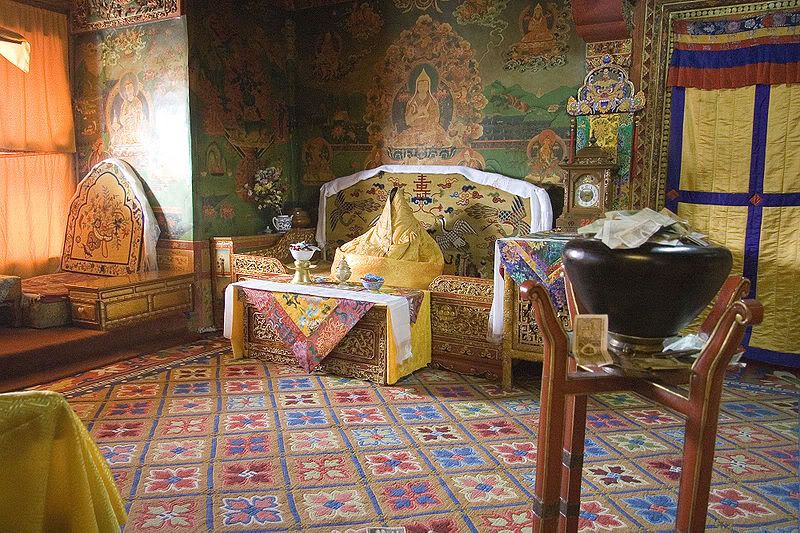
The story of the 14th Dalai Lama’s escape from the palace as told by Wiki:
“It was from the Norbulingka palace that the Dalai Lama escaped to India on 17 March 1959 under the strong belief that he would be captured by the Chinese. On this day, the Dalai Lama dressed like an ordinary Tibetan carrying a rifle across his shoulder left the Norbulingka palace and Tibet to seek asylum in India. As there was a dust storm blowing at that time he was not recognized. According to Reuters, “The Dalai Lama and his officials, who had also escaped from the palace, rode out of the city on horses to join his family for the trek to India”. The Chinese discovered this "great escape" only two days later. The party journeyed through the Himalayas for two weeks and finally crossed the Indian border where they received political asylum. Norbulingka was later surrounded by protesters and subject to an attack by the Chinese.”
After exploring the palace grounds we crossed the street to take a look inside the Tibet Museum. Henk and I walked around reading through some of the captions only to find blatantly bias statements from the Chinese government, and frankly, pure propaganda. They actually had the audacity to call their 1959 invasion of Tibet the “liberation of Tibet.” Since the ‘historical story’ they have on display at the museum wasn’t even worth reading (unless you like being under Big Brother’s control) I’ll just talk about some of the artifacts we saw instead. One of the more interesting things was a display of Tibetan Opera masks, similar to what we saw briefly at the show the other night. This time however, we learned that the color of the masks has significance. White or black stands for deceit; yellow for loyalty; red for authenticity; and blue stands for justice and bravery. We also came across a few 17th century medical diagrams that showed supposed causes and cures for various diseases, and different displays of Tibetan thangka paintings from a range of various Tibetan ‘schools of art.’

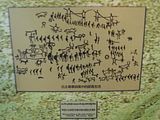
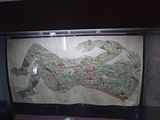
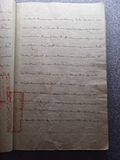
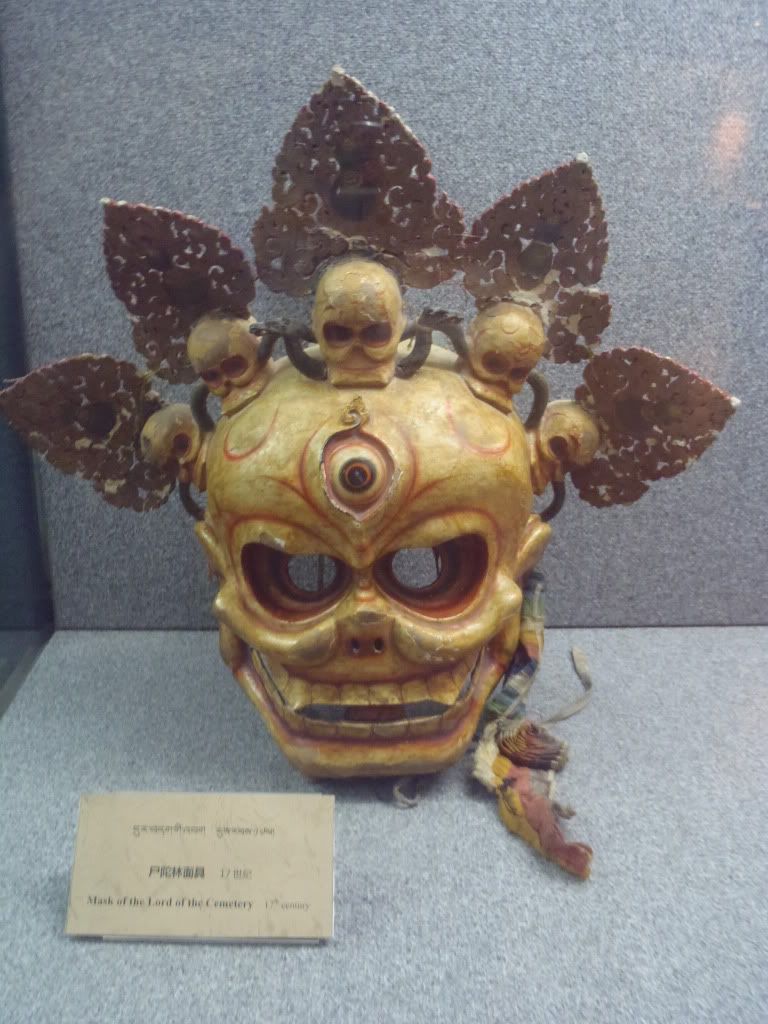
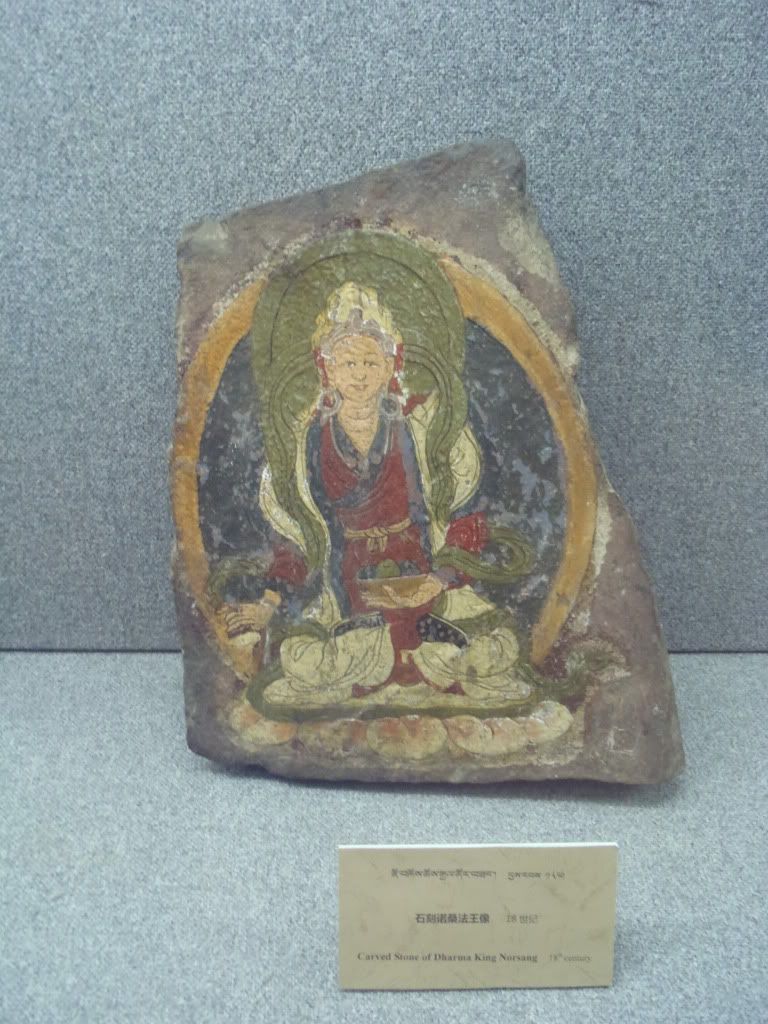
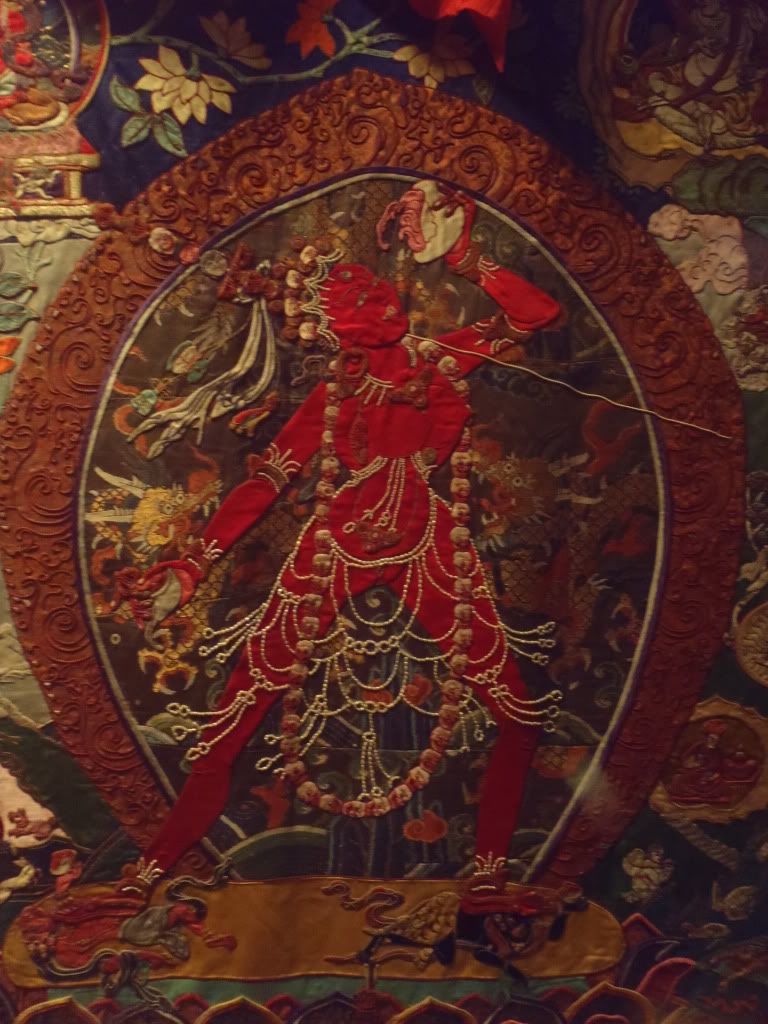
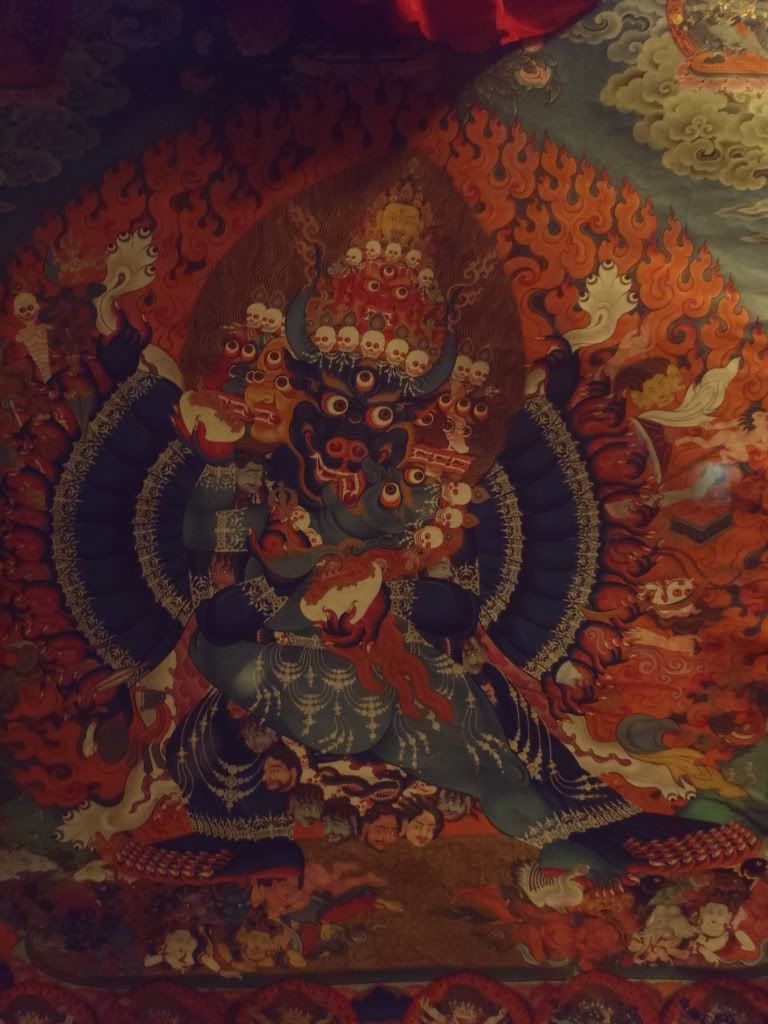
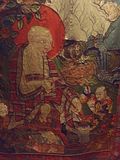
I then quickly ran upstairs to snap a few photos of some old dusty stuffed animals while Henk waited for me. Once that was finished we met Sam and our guide who both were waiting outside (it was a bit hot in the museum with no A/C) and the four of us grabbed a taxi and headed back to Lhasa. Henk went out later in the evening to Snowland and brought back some dinner for us – a yak stew for himself, a pizza for me, and a delicious chocolate cake for the two of us to share. Yay for surprise cake!! The next day we’d be going to the Potala Palace and we needed our rest!
Francesca

As I walked around the room scanning the cases, I saw tons of really cool masks, and lots of demon faces. A little introduction about Tibetan Opera from China Culture website:

“There is a beautiful legend about the Tibetan Opera in its present form. During the 14th century, a high-ranking monk and bridge builder named Drupthok Thangthong Gyalpo decided to build iron bridges across all of the major rivers in Tibet to improve transportation and facilitate pilgrimages.
To fund the project, Thangthong Gyalpo created a singing and dancing group of seven beauties who danced while he played the cymbals and drums. They performed throughout Tibet to earn money for his bridge project. This is believed to be the source of the present Tibetan Opera.”


The shows we saw were a short and entertaining, and there were a bunch of them. The group started out with the ‘Blue Mask Sect Dance’ and then followed with an Eastern Tibet dance done by girls with guitars. The third dance we saw was the ‘Cham Religious Dance’ (one of the many types of Cham dances) and one of the ‘Lhasa-area traditional dances’ that I dubbed the ‘fuzzy-hat dance’ since that’s exactly what the girls wore. Finally, the show gave us a ‘Nomad Dance’ that involved nomads and people dressed up like yaks (not traditional, more like a short skit, but quite funny to watch!) and a dance they titled ‘Namtso Dance.’ The final show was a bit of a ‘fashion show of Tibet’ that involved men and women labeled from different ‘areas’ of Tibet coming out to show what clothing from their area looks like. At the same time, we were introduced to a few important figures in Tibetan history – the inventor of Tibetan writing, the founder of Tibetan medicine, the founder of Tibetan opera, etc.









Once the show ended, we got to take a few pictures with the actors and actresses before heading back to our hotel. One thing I have to mention is as we were walking back, we realized that it was half past 8:00 PM at night, and it was still completely bright out. We quickly realized that Tibet was on the same time-zone as China (Beijing time) even though it’s a completely different location, making the area in reality more than 2 hours different by the sun. Since China thinks only of Beijing/Shanghai, this is the way it is! A sun that doesn’t set until nearly 9:00 PM at night… Also note the gigantic carcasses of yaks and cows we spotted all along the way. Our hotel was near the Muslim Quarter – since Buddhist abhor killing animals it only made sense for the Muslims to take up the noble job of butchering.



Anyways, the next morning we had to get up early to see our first sites in Lhasa. We’d passed by it now quite a few times, but we had yet to go into Jokhang Temple. Ray picked us up at the hotel and we were there around 10:00 PM to buy our tickets. It was insanely crowded, but turns out we were actually lucky. Ray explained that despite the temples’ vast 25,000 square meters and four stories, most times tourists are only allowed a strict 15 minutes in the temple due to the even more massive amount of visitors -- giving him hardly any time to explain the sites inside. But we didn’t have a time limit since it was a Sunday, the only day tourists are the only ones allowed inside. Jokhang Temple is the focal point of pilgrims to Lhasa, where they come to honor the founders of their country and the founders of Buddhism. The temple was built by King Songtsen Gampo in 647 AD and is thus one of the ‘must-sees’ of Lhasa. We made our way through the masses of people inside the temple, coming out onto a decently spacious courtyard. Here we took some time to understand the background of the temple.


Here is some helpful information from the Lonely Planet Tibet, which we learned from Ray while inside Jokhang Temple:

“[There is a story] …of a vast, supine demoness whose body straddled all of the high plateau. It was Princess WenCheng, the Chinese wife of King Songtsen Gampo, who divined the presence of his demoness. Through Chinese geometric calculations she established that the heart of the demoness lay beneath a lake in the centre of Lhasa, while her torso and limbs far away in the outer dominions of the high plateau. As in all such fables, the demoness can be seen as a symbol, of both the physical hardships of Tibet and the existing Bon clergy’s hostility towards Buddhism; both had to be tamed before Buddhism could take root there. It was decided that the demoness would have to be pinned down. The first task was to drain the lake in Lhasa of its water (read life-blood of the demoness) and build a central temple that would replace the heart of the demoness with a Buddhist heart. The temple built there was the Jokhang… a serious of lesser temples, in three concentric rings, were (also) conceived to pin the extremities of the demoness.”



One of the sections of the temple we came to was covered in a mural. This mural depicted the temple’s construction, showing the temple being built over a lake and stupa, with goats helping the process by carrying earth on their backs to fill the lake. In fact, the temple was under construction while we were inside. We could see the workers on top of the roofs hitting them to mend the packed clay and dirt. While the process looked really sketchy, Ray insisted that this traditional method would leave the temple waterproof for up to 7 years! Later, when Henk and I climbed the stairs to the top of the temple, we witnessed a group of Tibetan construction workers breaking out into spontaneous dance in the middle of their work-- which Ray said was actually pretty normal for Tibetans! They are people prone to displaying themselves in song!

We learned the Dalai Lama (including the present 14th) used to preside over huge debates in the courtyard we stood in. There were once over 10,000 monks gathering here to question what others knew. Now the regulations imposed by the Chinese let hardly any ‘unsupervised’ monks gather in the area, let alone allow them to hold their former large debates. There was a huge cooking pot, bigger than the one we’d see at the festival, standing in the courtyard. Ray estimated it could feed 5000 to 6000 monks and explained that the money floating in the water on top was left by pilgrims.

In fact, there was money pretty much everywhere you looked in the temple! At every statue someone was making a donation, at each display someone was smearing yak-butter on it for their devotion, or scooping yak-butter out of bags into large burners to light up and melt (thus making the temple smell constantly of baking cookies!) Our guide explained the symbolism of the butter by comparing putting butter in the burner plate to putting a drop of water into the ocean… neither have a huge chance of drying out/burning out right away once they are in a large ‘pool’ with others; thus they last longer and thus one makes more continuous merit on their one-time gift. We even learned that occasionally someone accidentally drops money on a ‘regular’ (non-holy) item or area and pilgrims, not knowing any better, think it must be something sacred and add their own donation as well! Better safe than sorry, I guess…
Ray pointed out to us the image of two deer, flanking either side of a large wheel. The dharma wheel is symbolic of Buddha’s teachings, specifically the path to enlightenment. This wheel of law is symbolized by an eight-spoked chariot wheel representing the eight-fold path, but there can be other numbers of spokes as well representing other aspects of Buddhism. The deer on either side of the wheel represent the Deer Park at Sarnath in India where Buddha taught his first disciples. Ray specified to us that since Buddhism believes our experience of life is a ‘long dream’ (as opposed to the ‘short dreams’ we have every night during sleep) the wheel of dharma aids us in our ultimate goal of enlightenment or ‘waking up from that dream.’ This occurs when realization sets in and emotion is thus extinguished… but this takes multiple lifetimes and rebirths for one mind to achieve.

Then the three of us walked around the inner chambers of the temple, while Ray pointed left and right at various images, telling us little bits of information about their lives.

Mara, for instance, was a demon who constantly tried to tempt the Buddha with visions of beautiful women. While he is a demon, Mara has not traditionally been seen as ‘evil’ but rather as annoying – in fact, many of the stories involving Mara’s antics are more humorous in nature than good/evil battles. The wiki has a nice little chart of the ‘four senses’ in which Mara is understood by Buddhists; they are as follows:
• Klesa-mara, or Mara as the embodiment of all unskillful emotions.
• Mrtyu-mara, or Mara as death, in the sense of the ceaseless round of birth and death.
• Skandha-mara, or Mara as metaphor for the entirety of conditioned existence.
• Devaputra-mara, or Mara the son of a deva (god), that is, Mara as an objectively existent being rather than as a metaphor.
Another image we saw was Vajrapani whose name is a combination of ‘thunderbolt/diamond’ and ‘in the hand.’ This is exactly what his representation looked like! His eyes were wide and bulging, his hair was completely wild in all directions, and he looked really, really powerful. This is pretty apt since he is supposed to be the figurative representation of the Buddha’s power as well as the Buddha’s protector.
Next we saw a stupa that was “self-raising,” meaning humans don’t know where it came from/didn’t create it. There was also the ‘Temple of Compassion Buddha,’ and Henk and I understood that the ‘Compassion Buddha’ actually represents the 14th Dalai Lama – since he is believed to be a reincarnation of this Buddha, which one can recognize by its 4 arms or 11 heads. The reason the Compassion Buddha looks the way it does is because it cannot handle the suffering of all people and have compassion for all of them, but still it tries to do so. As a result, the Compassion Buddha ‘breaks,’ splitting itself into multiple parts so that it has more arms to help, eyes to see, minds to feel, etc.
We now approached the most important chapel in the temple: (and in fact, in all of Tibet) the ‘Chapel of Jowo Shakaymuni.’ This image houses a 1.5m sitting image of Shakyamuni at the age of 12. The Jowo image was a gift from the Chinese Princess Wencheng to her husband King Songtsen Gampo, and was miraculously protected from the Chinese Red Guards during the ‘Cultural Revolution’ their leader Mao Zedong spearheaded that completely decimated almost all of Tibet’s ancient religious and cultural artifacts, including 6,000 of Tibet’s 6,400 temples.

The Wiki explains the statue’s origin as a gift, and the ancient effort to protect it:
“Jowo Rinpoche statue was owned by the king of Magadha who gave it to a Tang emperor of China, whose daughter, Wenchen Kongjo, who carried it to Lhasa via Lhagang in a wooden cart when she married King Songtsen Gampo. During Mangsong Mangtsen's reign (649-676), because of a threat that the Tang Chinese might invade, Princess Wen Cheng is said to have hidden the statue of Jowo Rinpoche in a secret chamber in the Jokhang.”
This chamber was built to look as if there was a wall rather than a door, and we passed the hiding chamber shortly after viewing the statue itself.
A description of the statue from a travel photo site: “The Jowo sits on a majestic massive three-tiered stone platform. Two silver-plated dragons presented by the Chinese emperor entwine the ornate pillars that support an intricate double canopy over the Jowo. An ornate crown of coral, turquoise, diamonds, rubies, and other precious gems, sits on the Jowo’s head.” Henk and I followed Ray a bit closer to the image, where we saw Buddhist monks doing something that looked quite strange. “Are they painting it?” I asked in disbelief. From this question we learned that Buddhist pilgrims who are eager to show their level of dedication to the Jowo image buy liquid gold to add to the face or body. It supposedly cost just 480 RMB (US$70) to give the Buddha’s face an extra coating of gold leaf.
We watched the painting in awe until we were pushed further on – there were so many people! We next went upstairs and explored the open roof of the temple where we could take tons of pictures of the surrounding streets and structures. Here are some of the results:


Finished with the Jokhang, the three of us explore the streets of Barkhor, going into a few interesting shops and walking through the markets. We soon came across one of the stalls selling colorful thread bunches, the same thread the Tibetan women all had in their braided hair. Henk and I asked Ray if he could ask the stall keeper if she would mind braiding my hair if we bought some threads from her. She complied cheerily, looking amused that I wanted to look like a local Tibetan. Once my new hairstyle was in place, we took a break and popped into a traditional tea house for a sip of sweet milky tea. After that our shopping walk continued until we arrived at the Yak Hotel – one of the more famous places to stay in Lhasa. It was here that we were supposed to meet Sam, the girl I contacted online to join us on our Tibet trip. Her taxi ran a bit late so we chilled out in the lobby, and when she finally arrived we made a quick stop to drop her bags at the agency that arranged our tour before heading for lunch.







After a quick lunch at Snowland of delicious butter chicken and butter naan for myself and amazing yak sew for Henk (I recommended it cause it sounded good!) which turned out really, really good, we took a taxi to Potala to book our tickets for the next day. After that we had a date with Norbulingka, the former Dalai Lamas Summer Palaces’, around 3:00 PM for a visit so we took another taxi and were there in a flash.

Norbulingka (the name meaning ‘Treasure Garden’ in Tibetan) is a group of summer palaces built in the mid-1700’s for the 7th through the 14th Dalai Lamas. It was the traditional summer residence of the successive Dalai Lamas from the 1780s up until the Chinese takeover in the late 1950s. Not all of the Dalai Lamas built their own little palace, but some of them simply used the already-constructed palaces of former Dalai Lamas. The notable Lamas who built their own palaces were the 7th, 8th, 13th, and 14th. While the nearby Potala Palace was the winter residence of the Dalai Lama and his staff, Norbulingka was the summer residence, and even included large outdoor gardens to emphasize this. It’s common that during the summer, people come to ‘chill out’ in the park and when we arrived there we saw them all hanging out for the festivities of the current Shoton Festival. There was also a zoo apparently in the park but we weren’t excited about going inside since Ray heard from a friend that the animals looked really horrible and were being treated pretty badly. We won’t pay money to support that!
We first came across the 7th Dalai Lama’s palace, Kelsang Potrang. From a Tibet tourism website: “... is a perfect example of yellow hat architecture. Built by the 7th Dalai Lama, this is 3 floor building which has bedrooms, reading rooms, worship halls and a sanctuary as well.”

It was here that we learned some information about the various females (or female aspects of male figures) in the Buddhist pantheon, including White and Green Tara and the female longevity Buddha. Tara is one of the most popular figures in Tibetan Buddhism. She is the “mother of liberation” and is represented in many different forms of Tara – green Tara, white Tara, red Tara, etc. Tara represents success in work and victory in achievements. A good story about Tara’s origin and list of Tara-types from Wiki:
“… there is a young princess who lives in a different world system, millions of years in the past. Her name is Yeshe Dawa, which means "Moon of Primordial Awareness". For quite a number of aeons she makes offerings to the Buddha of that world system, whose name was Tonyo Drupa. She receives special instruction from him concerning bodhicitta — the heart-mind of a bodhisattva. After doing this, some monks approach her and suggest that because of her level of attainment she should next pray to be reborn as a male to progress further. At this point she lets the monks know in no uncertain terms that from the point of view of Enlightenment it is only "weak minded worldlings" who see gender as a barrier to attaining enlightenment. She sadly notes there have been few who wish to work for the welfare of beings in a female form, though. Therefore she resolves to always be reborn as a female bodhisattva, until samsara is no more. She then stays in a palace in a state of meditation for some ten million years, and the power of this practice releases tens of millions of beings from suffering. As a result of this, Tonyo Drupa tells her she will henceforth manifest supreme bodhi as the Goddess Tara in many world systems to come.”
The most widely known forms of Tara are:
• Green Tara, known as the Buddha of enlightened activity
• White Tara, also known for compassion, long life, healing and serenity; also known as The Wish-fulfilling Wheel, or Cintachakra
• Red Tara, of fierce aspect associated with magnetizing all good things
• Black Tara, associated with power
• Yellow Tara, associated with wealth and prosperity
• Blue Tara, associated with transmutation of anger
• Cittamani Tara, a form of Tara widely practiced at the level of Highest Yoga Tantra in the Gelug School of Tibetan Buddhism, portrayed as green and often conflated with Green Tara
• Khadiravani Tara (Tara of the teak forest), who appeared to Nagarjuna in the Khadiravani forest of South India and who is sometimes referred to as the "22nd Tara."
The female longevity (which we were told was in the palace as a desire for the Dalai Lama to live a long life) Buddha, known as Usnisha-vijaya, is described as follows by the Wiki:
“She is an 8-armed longevity deity, who also stands for the Mother of All Buddhas. Like all Buddhist deities, she is essentially a manifestation of Emptiness acting as a bodhisattva. She is able to bestow longevity on beings not for selfish reasons, but for the purpose of helping all others towards enlightenment. She is a purification deity as well, invoked in the presence of the dead, and she is also invoked as a means of settling disputes.”
One of the décor elements I immediately noticed was the abundance of ‘Victory Banners’ (which looked like neckties to me) hanging all over the place inside the little palace. It was explained that these banners stood for victory over cruelty rather than any beings. For Tibetans there are 11 different types of victory banners, as they represent the 11 different methods to “overcome defilement.” We also saw a display of 7 carefully lined up bowls filled with water in front of some of the worshipping displays. In Buddhism, it does not matter if one can afford to offer gold or just simple water. What is important is your intention rather than the specifics of your act… if you wish you could offer gold but offer water, you might as well have offered gold! On the other hand, if you wish you didn’t have to offer anything or show respect, and you offer the maximum amount of gold, no good will come of this act. You didn’t really mean it!

The palace built by Jampel Gyatso, the 8th Dalai Lama, was called Tyoksil Potrang and was surrounded by water elements. The 8th Lama added on a lot of the palaces and gardens to the complex including three temples and a bunch of fruit trees.

It was the 13th and 14th Dalai Lamas who really brought the summer palaces to life, however. The 13th added huge red doors in the palace and had multiple carriages that had been presented to him by India, Nepal, China, etc. stored inside his palaces known as the Golden Lingka and Chensel Potrang.

The 14th Dalai Lama was reincarnated in the Amdo area of Tibet – and, as the traditional Buddhist thought goes - reincarnated in three areas: speech, body, and mind. From the time the previous Dalai Lama dies it takes 49 days for the Dalai Lama to be reborn. According to Wiki, there was a test given to the current Dalai Lama to determine if he indeed was the reincarnation of the previous Dalai Lama: “The little boy was presented with various relics, including toys, some of which had belonged to the 13th Dalai Lama and some of which had not. It was reported that he had correctly identified all the items owned by the previous Dalai Lama, exclaiming, "That's mine! That's mine!"
The 14th Dalai Lama’s Takten Migyur Potrang palace was by far the most extensive. He had an informal audience room where he would debate with friends and have discussions, he had a throne room, and tons of murals on the walls displaying the most important monasteries of Tibet. The Dalai Lama spent most of his time in his bedroom. This is also where he saw his mother as a child, although she wasn’t allowed to stay the night due to the tradition/requirement that no women should be with the Dalai Lama alone (even including his mother!) The Dalai Lama had a relaxation room which held a 1954 radio the Indian Prime Minister gave him so he would be tuned into the news of the world. He further had a formal audience room where restored murals displayed the realms of heaven/earth/hell: heaven/god, demigod/human/animal/hungry ghost/hell. Next to that was a little waiting room where those who had a meeting with the Dalai Lama would wait their turn, and then an official meeting room for those meetings to take place. The Dalai Lama lived in the palace in Lhasa until the Chinese made it sure he would have to leave.

The story of the 14th Dalai Lama’s escape from the palace as told by Wiki:
“It was from the Norbulingka palace that the Dalai Lama escaped to India on 17 March 1959 under the strong belief that he would be captured by the Chinese. On this day, the Dalai Lama dressed like an ordinary Tibetan carrying a rifle across his shoulder left the Norbulingka palace and Tibet to seek asylum in India. As there was a dust storm blowing at that time he was not recognized. According to Reuters, “The Dalai Lama and his officials, who had also escaped from the palace, rode out of the city on horses to join his family for the trek to India”. The Chinese discovered this "great escape" only two days later. The party journeyed through the Himalayas for two weeks and finally crossed the Indian border where they received political asylum. Norbulingka was later surrounded by protesters and subject to an attack by the Chinese.”
After exploring the palace grounds we crossed the street to take a look inside the Tibet Museum. Henk and I walked around reading through some of the captions only to find blatantly bias statements from the Chinese government, and frankly, pure propaganda. They actually had the audacity to call their 1959 invasion of Tibet the “liberation of Tibet.” Since the ‘historical story’ they have on display at the museum wasn’t even worth reading (unless you like being under Big Brother’s control) I’ll just talk about some of the artifacts we saw instead. One of the more interesting things was a display of Tibetan Opera masks, similar to what we saw briefly at the show the other night. This time however, we learned that the color of the masks has significance. White or black stands for deceit; yellow for loyalty; red for authenticity; and blue stands for justice and bravery. We also came across a few 17th century medical diagrams that showed supposed causes and cures for various diseases, and different displays of Tibetan thangka paintings from a range of various Tibetan ‘schools of art.’









I then quickly ran upstairs to snap a few photos of some old dusty stuffed animals while Henk waited for me. Once that was finished we met Sam and our guide who both were waiting outside (it was a bit hot in the museum with no A/C) and the four of us grabbed a taxi and headed back to Lhasa. Henk went out later in the evening to Snowland and brought back some dinner for us – a yak stew for himself, a pizza for me, and a delicious chocolate cake for the two of us to share. Yay for surprise cake!! The next day we’d be going to the Potala Palace and we needed our rest!
Francesca

0 Comments:
Post a Comment
<< Home